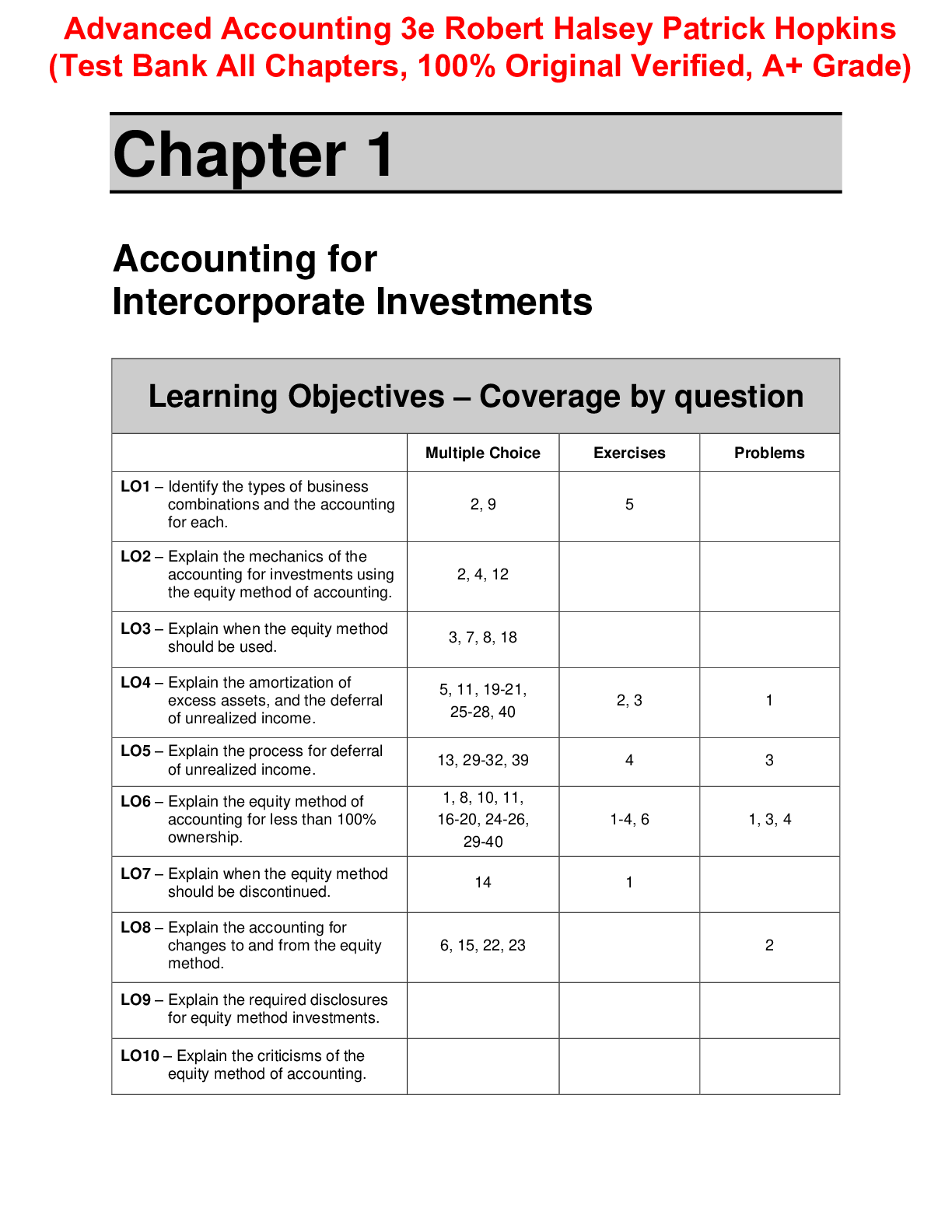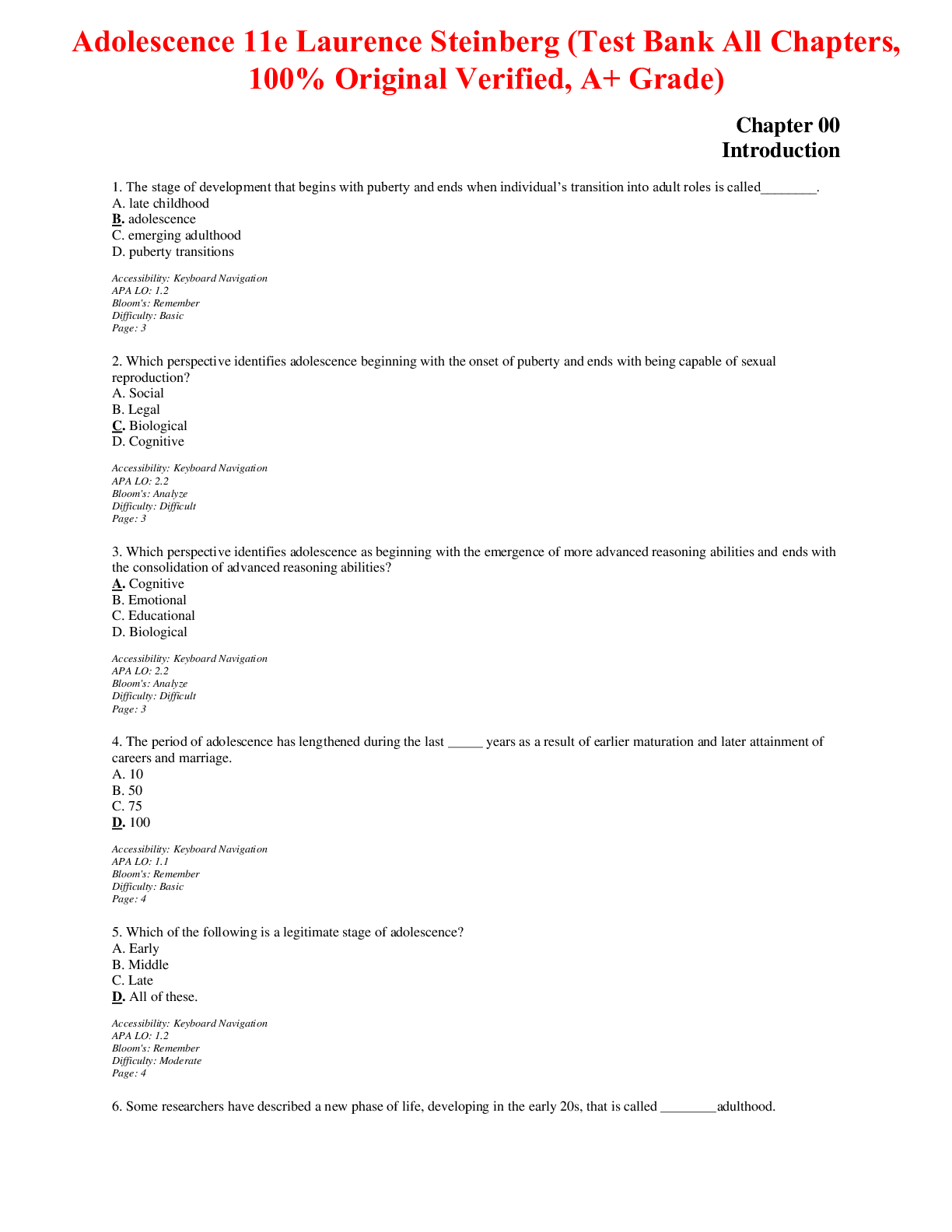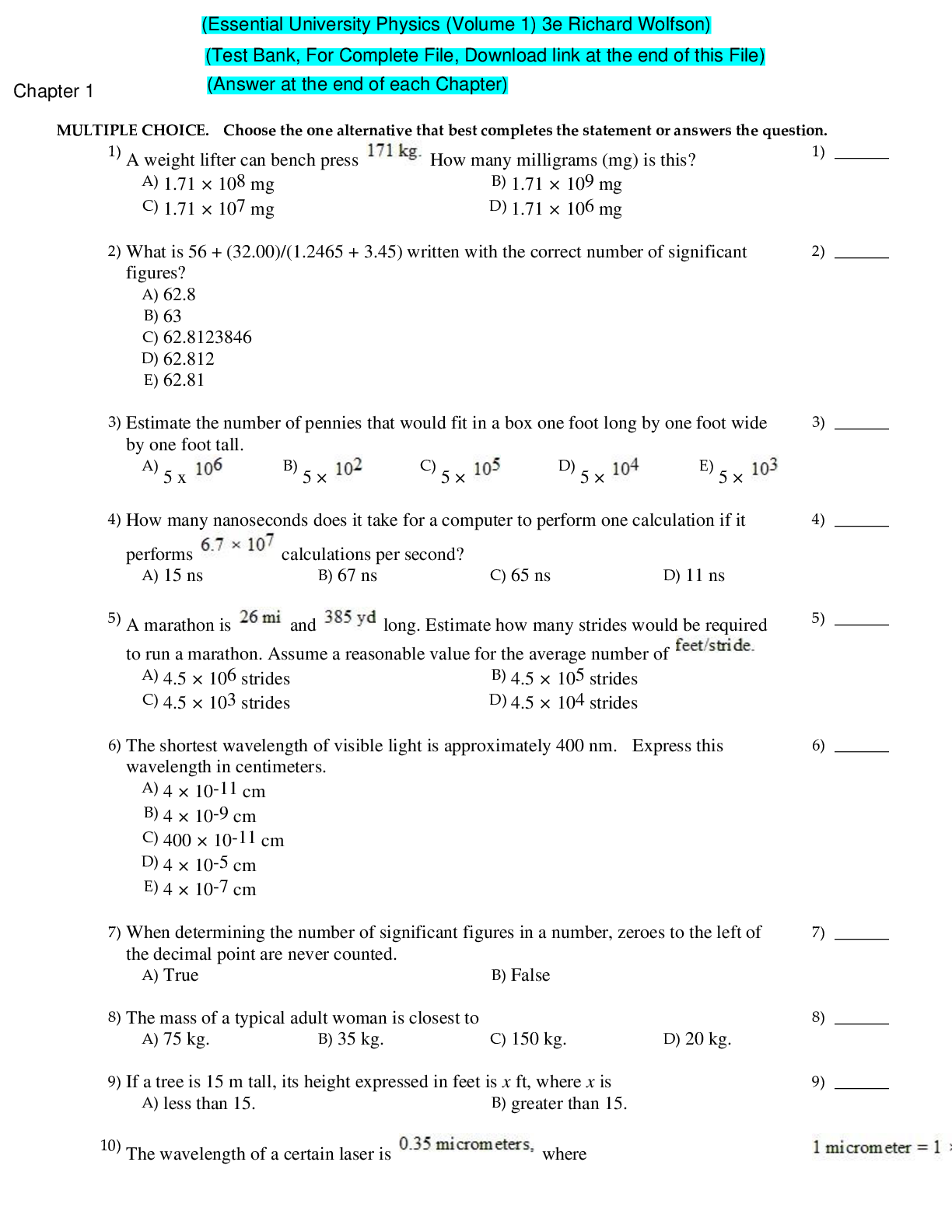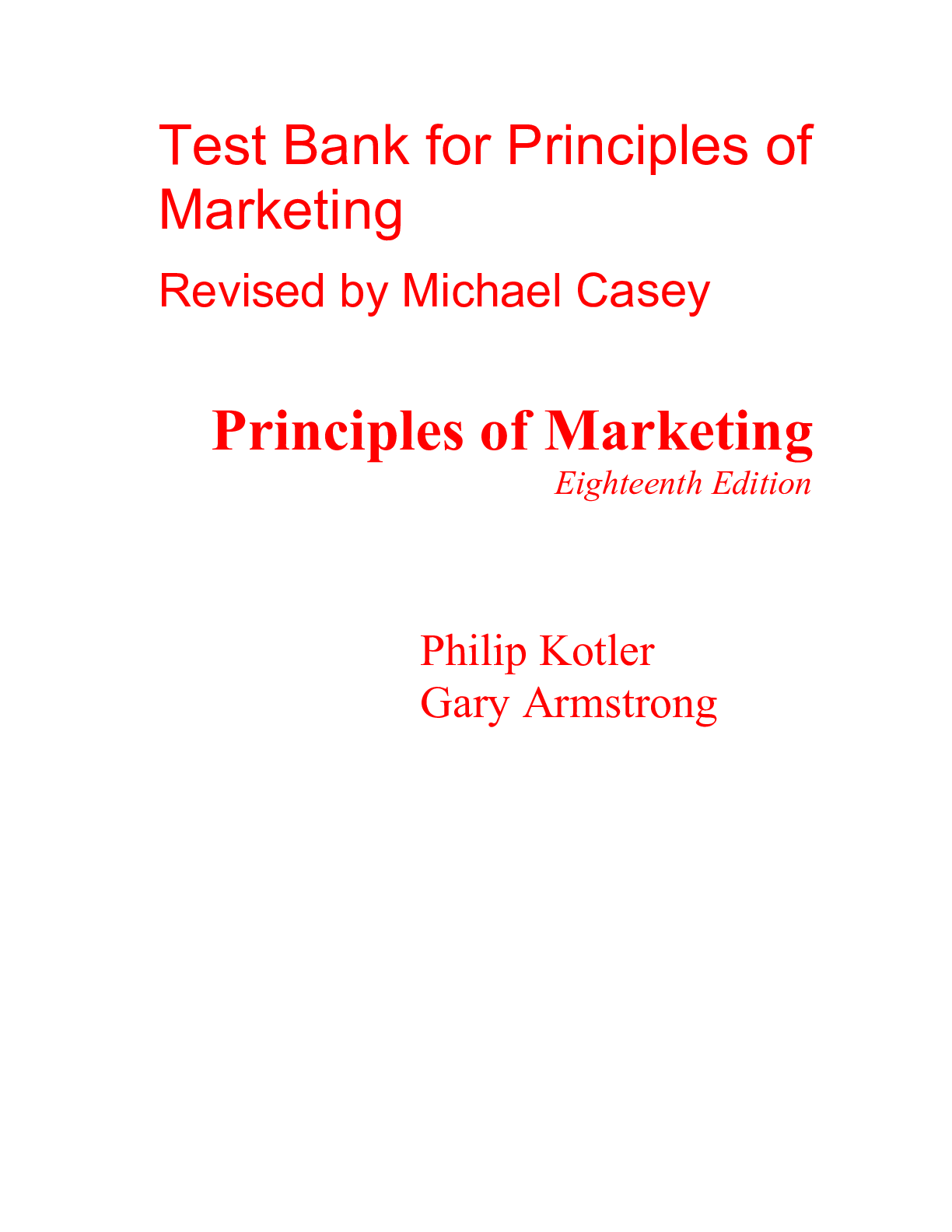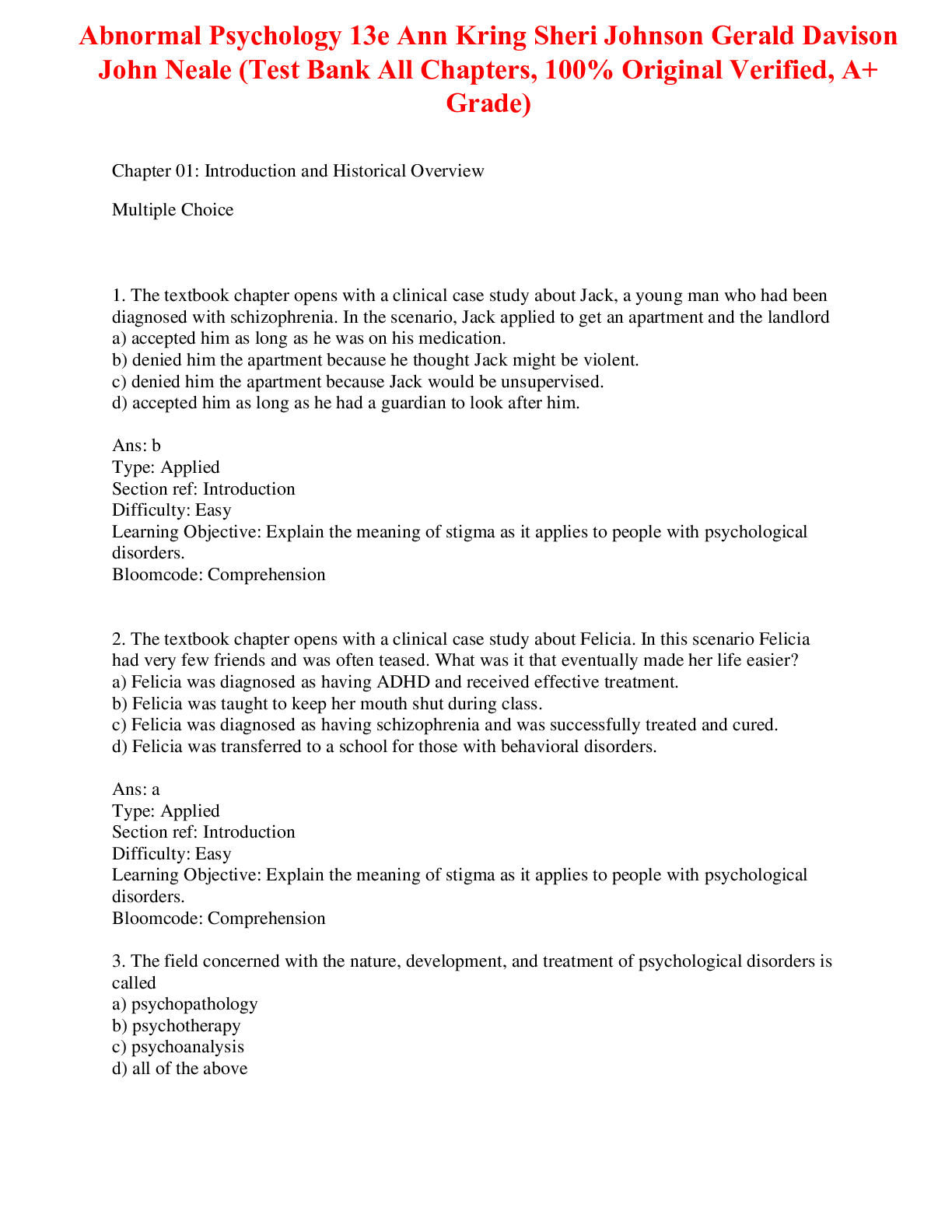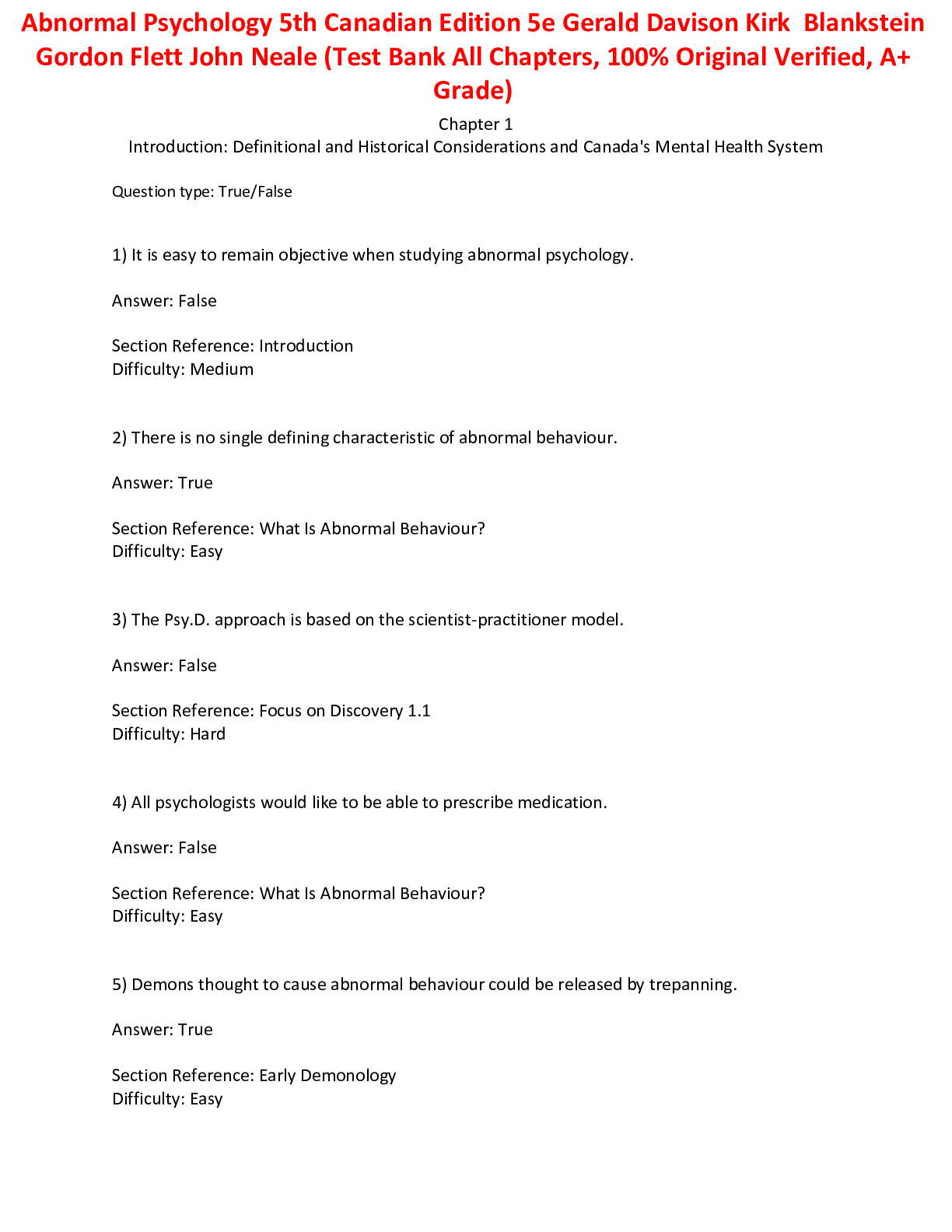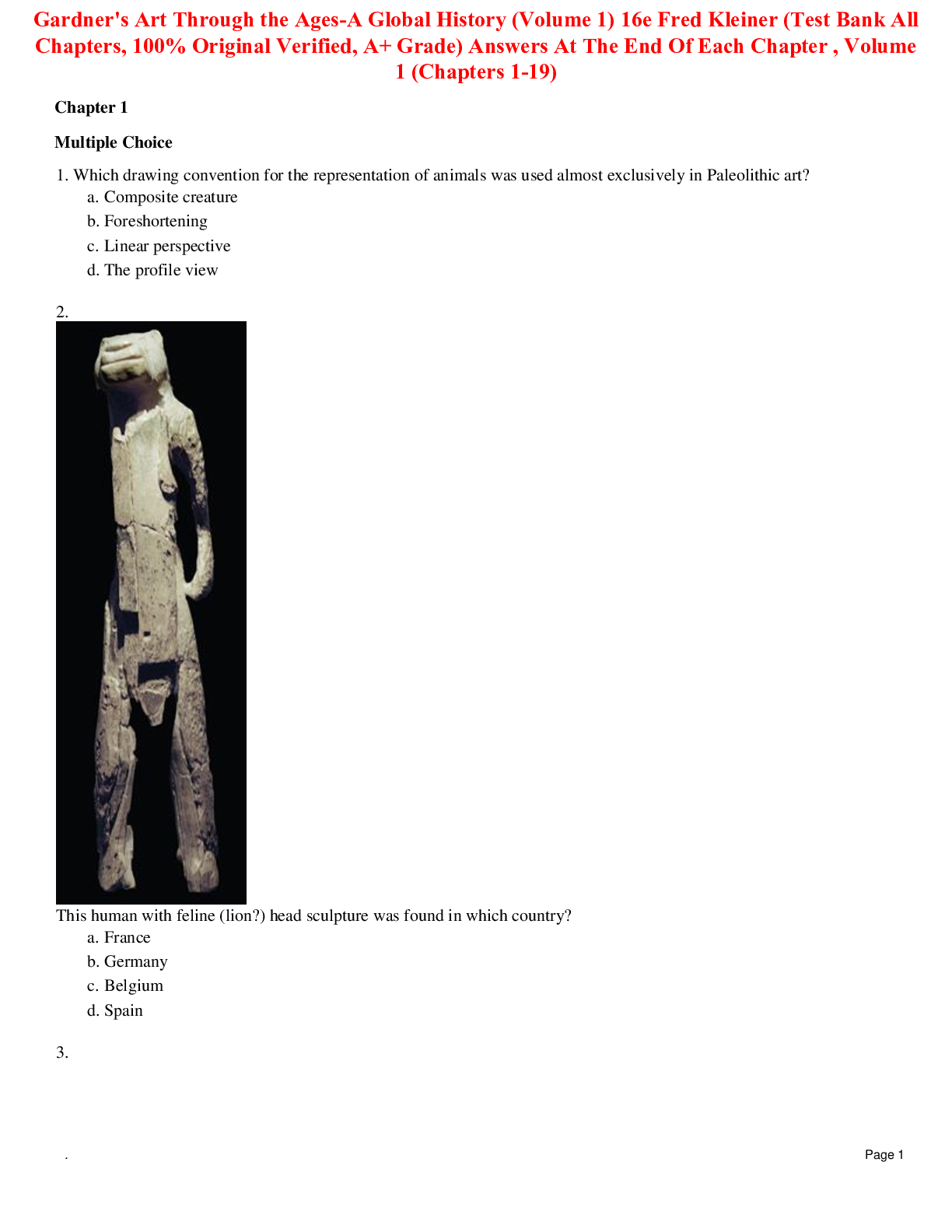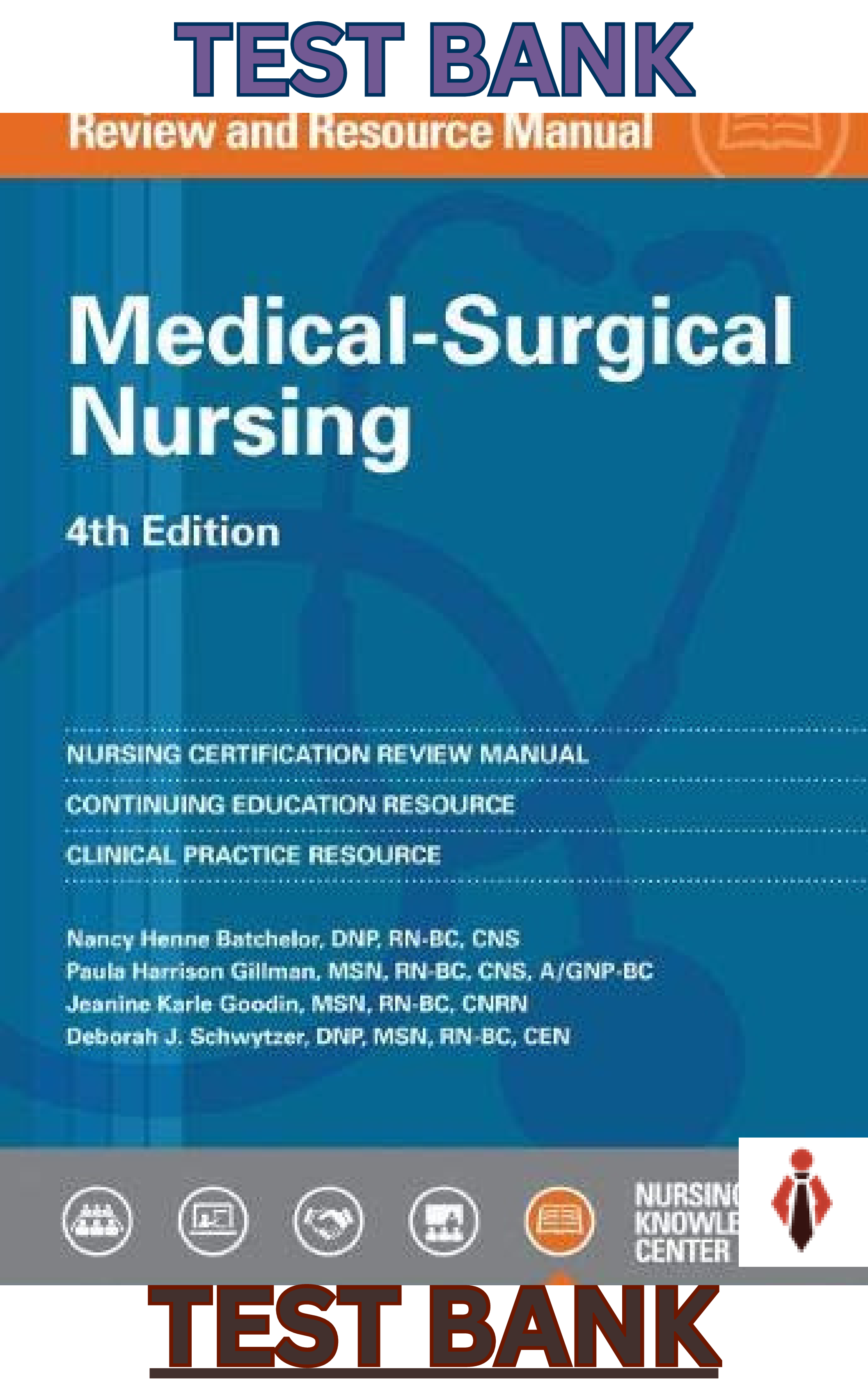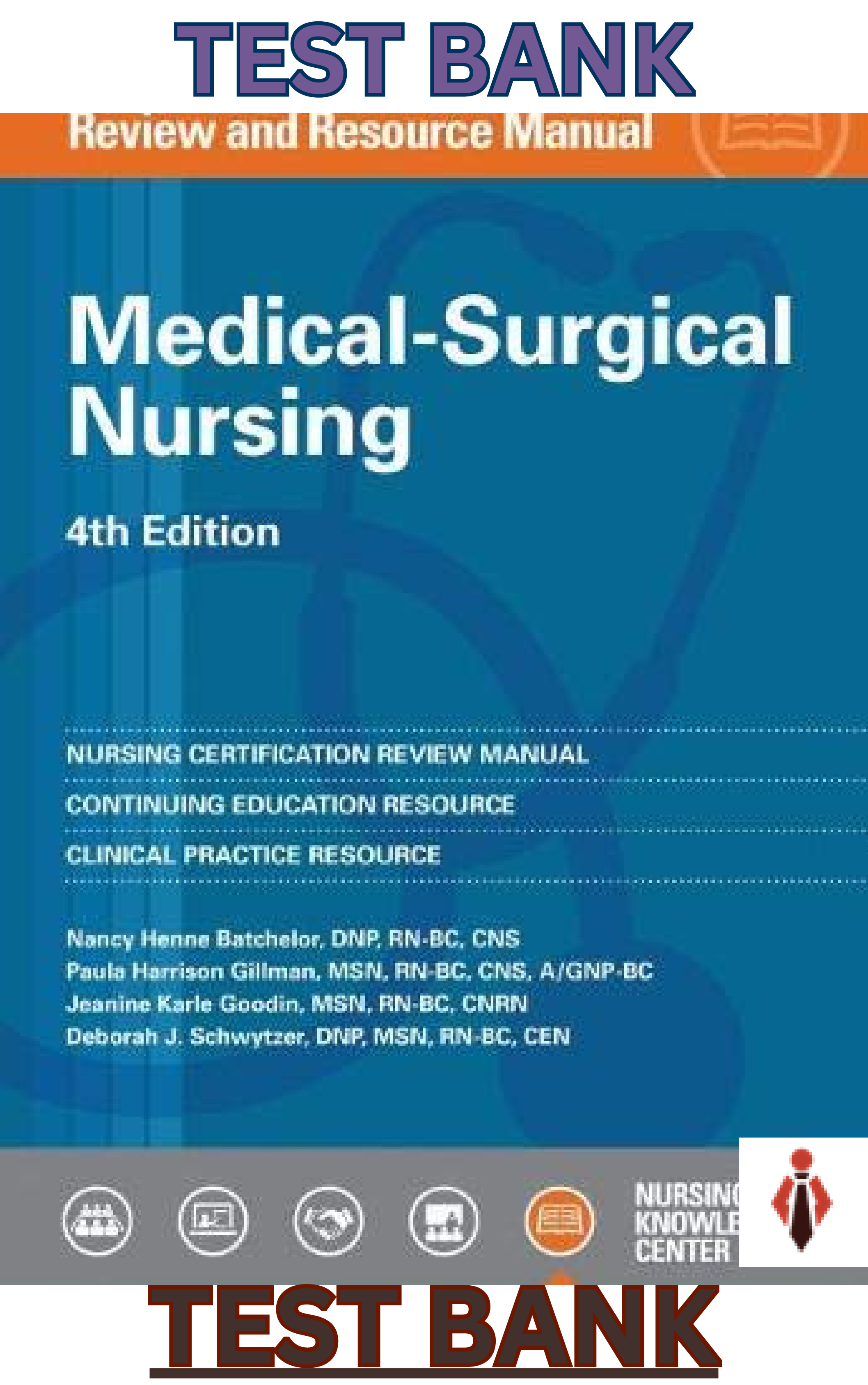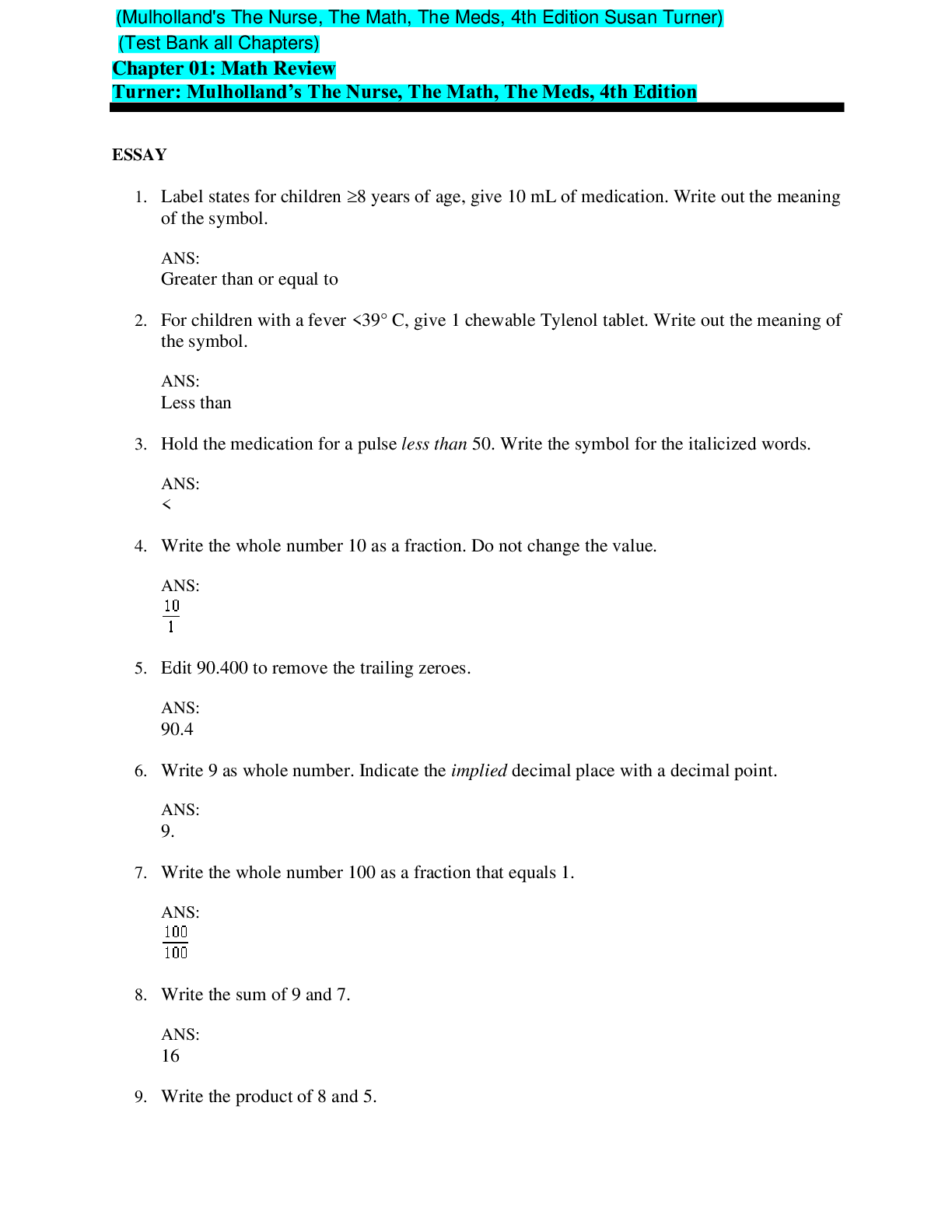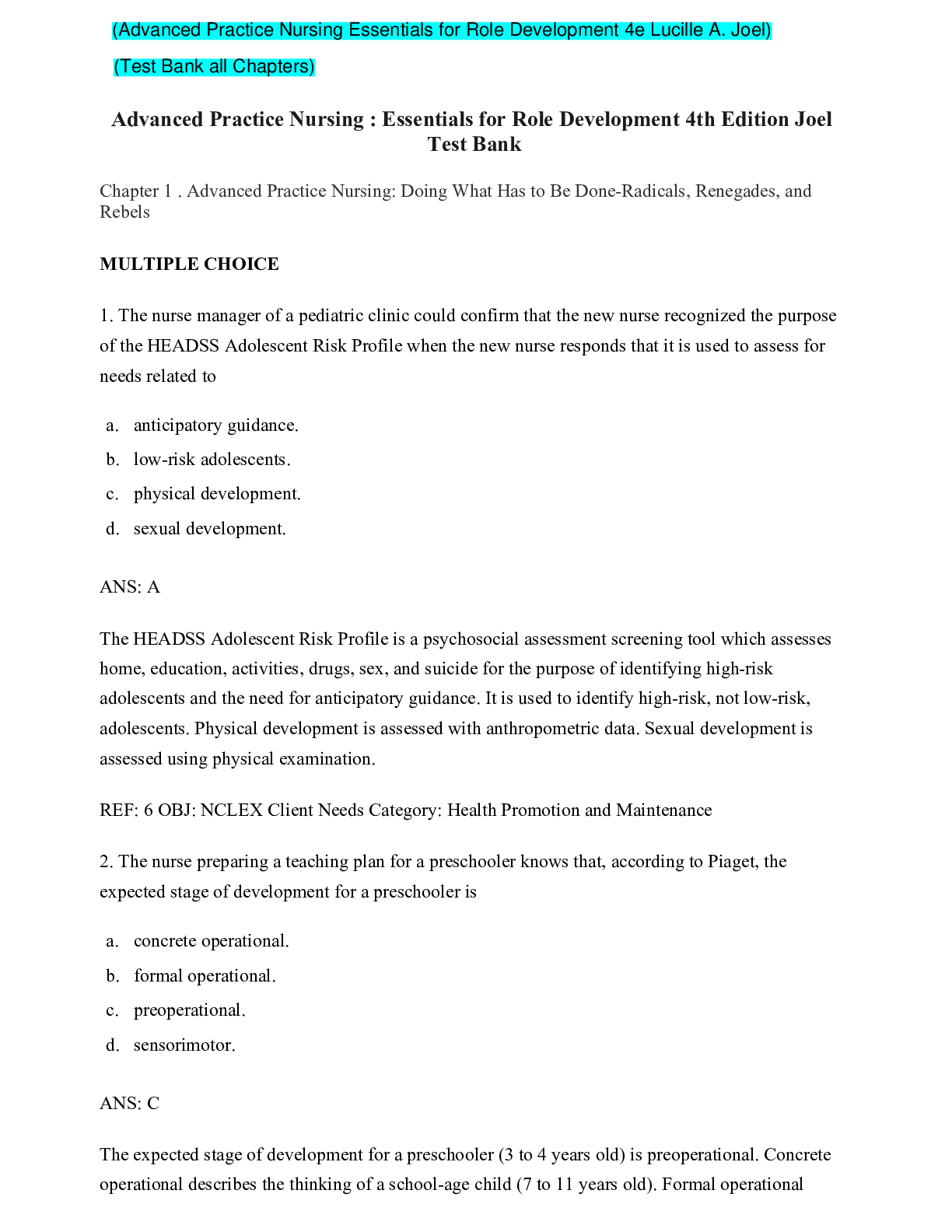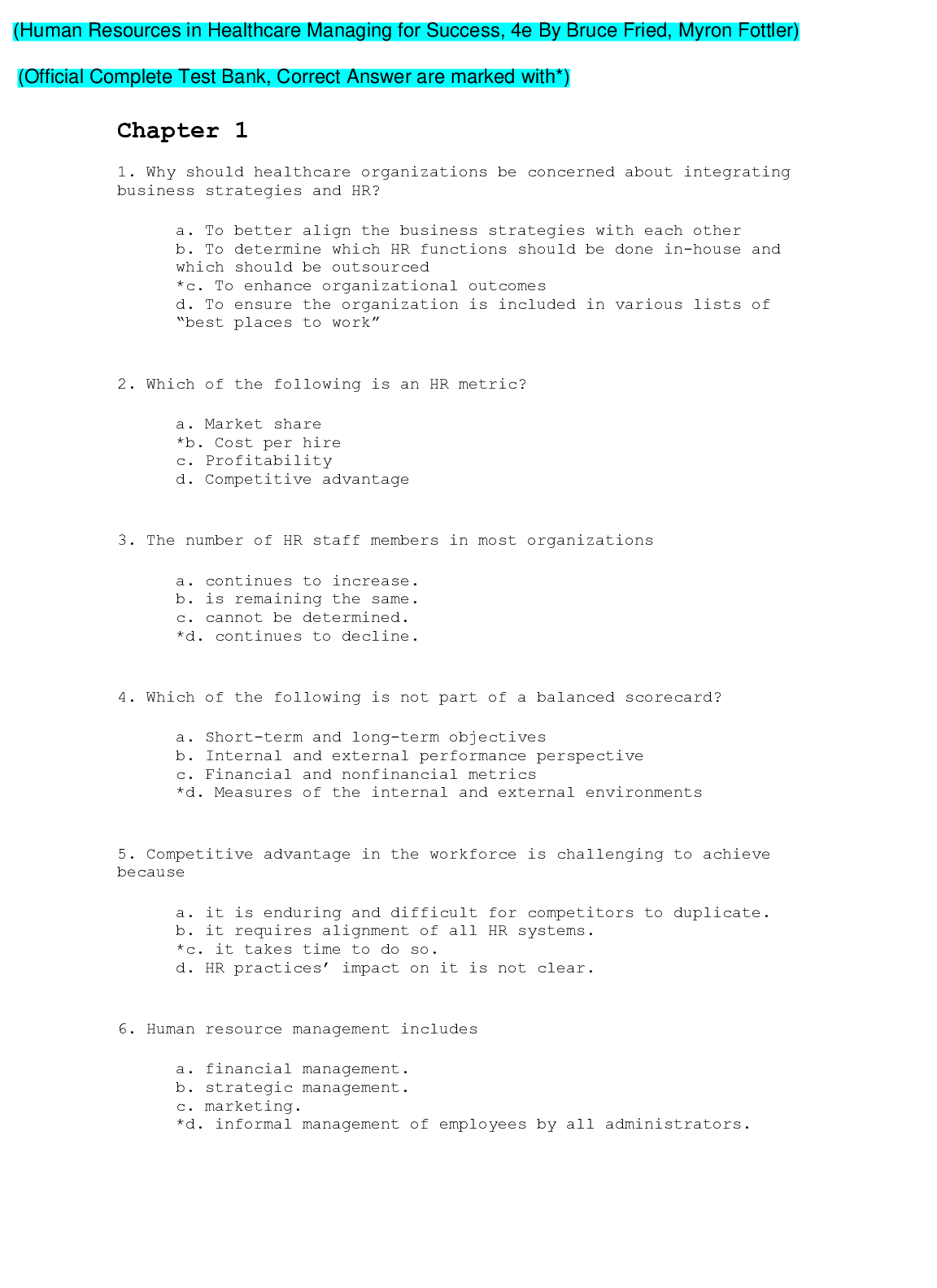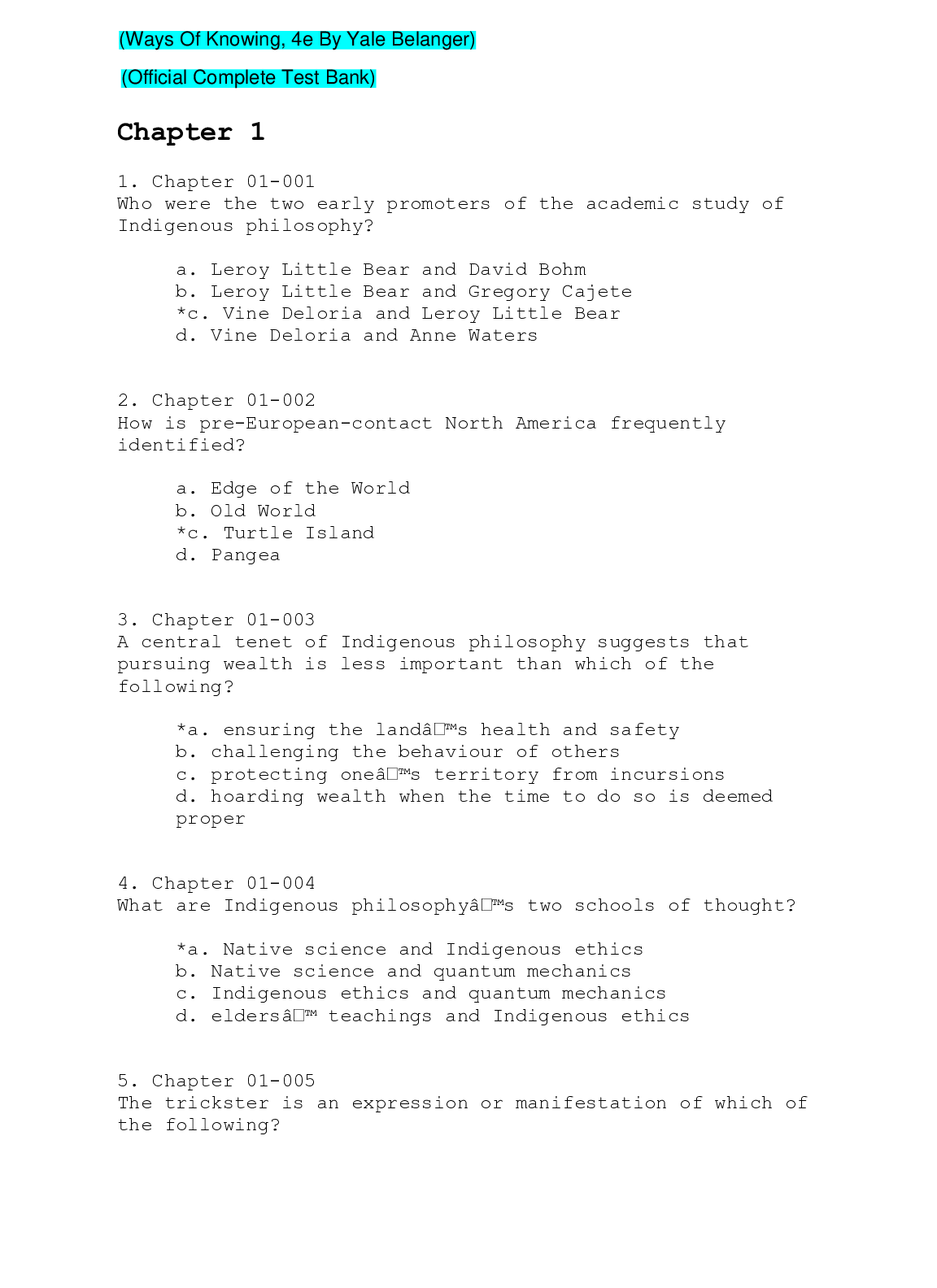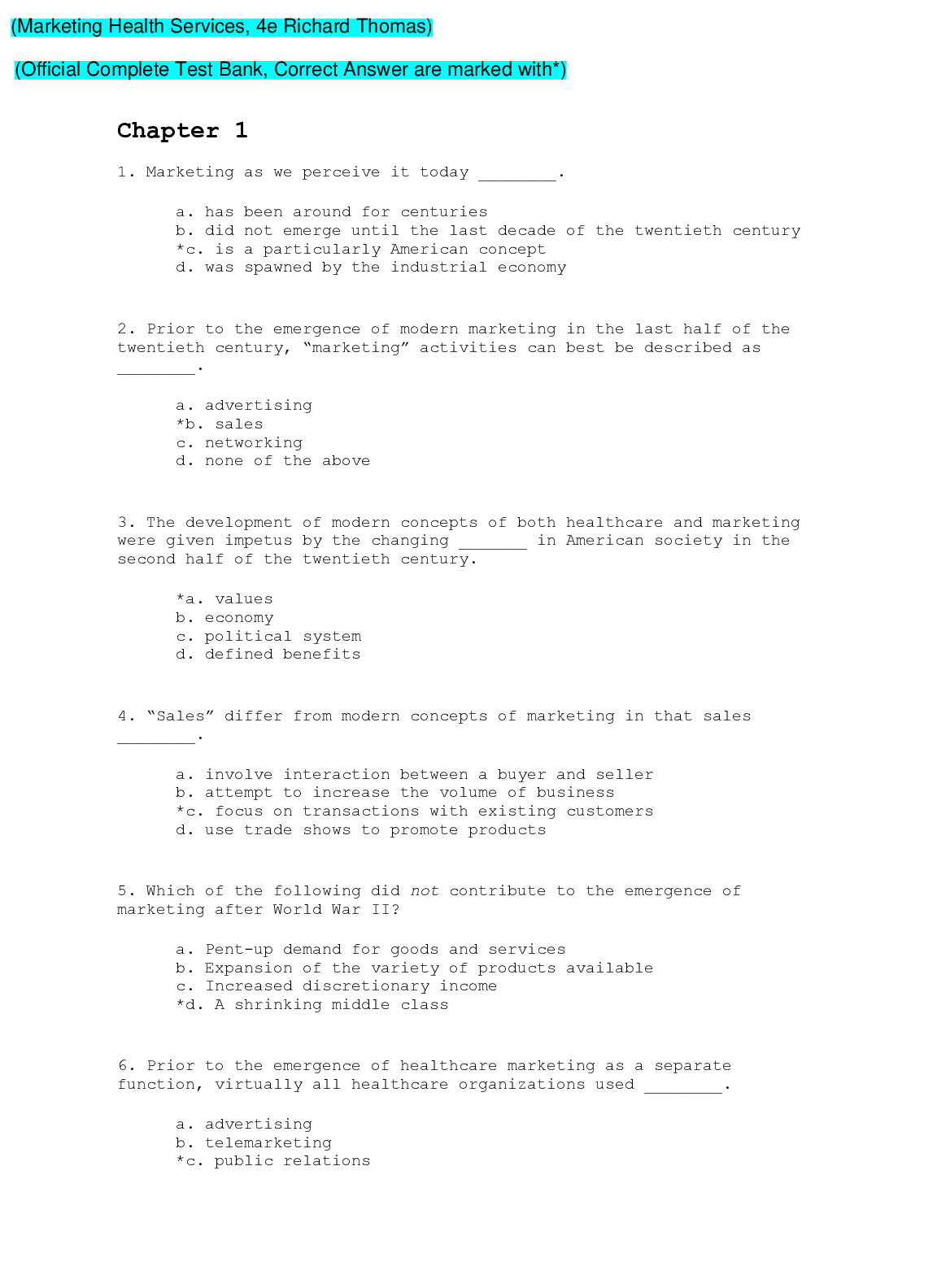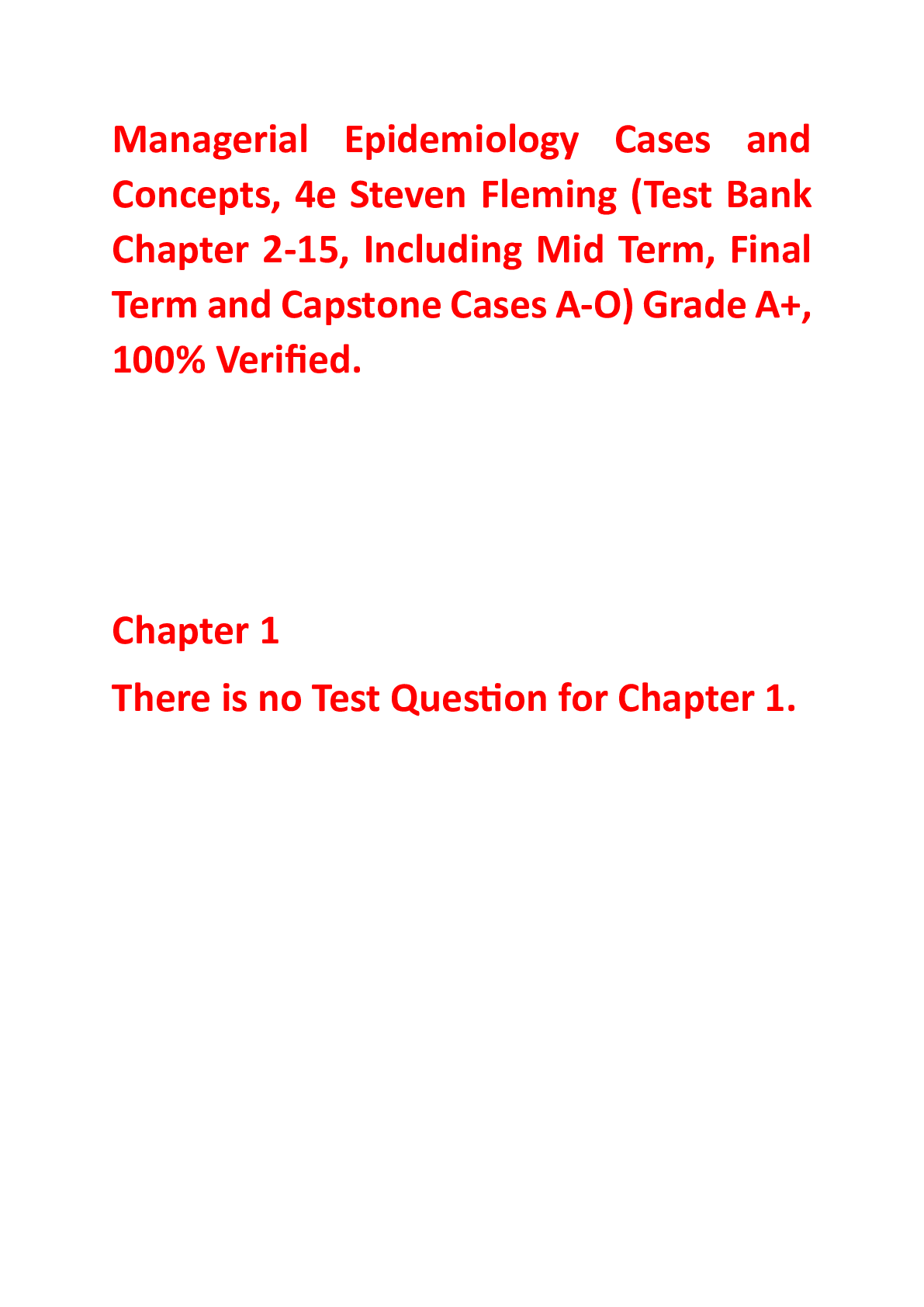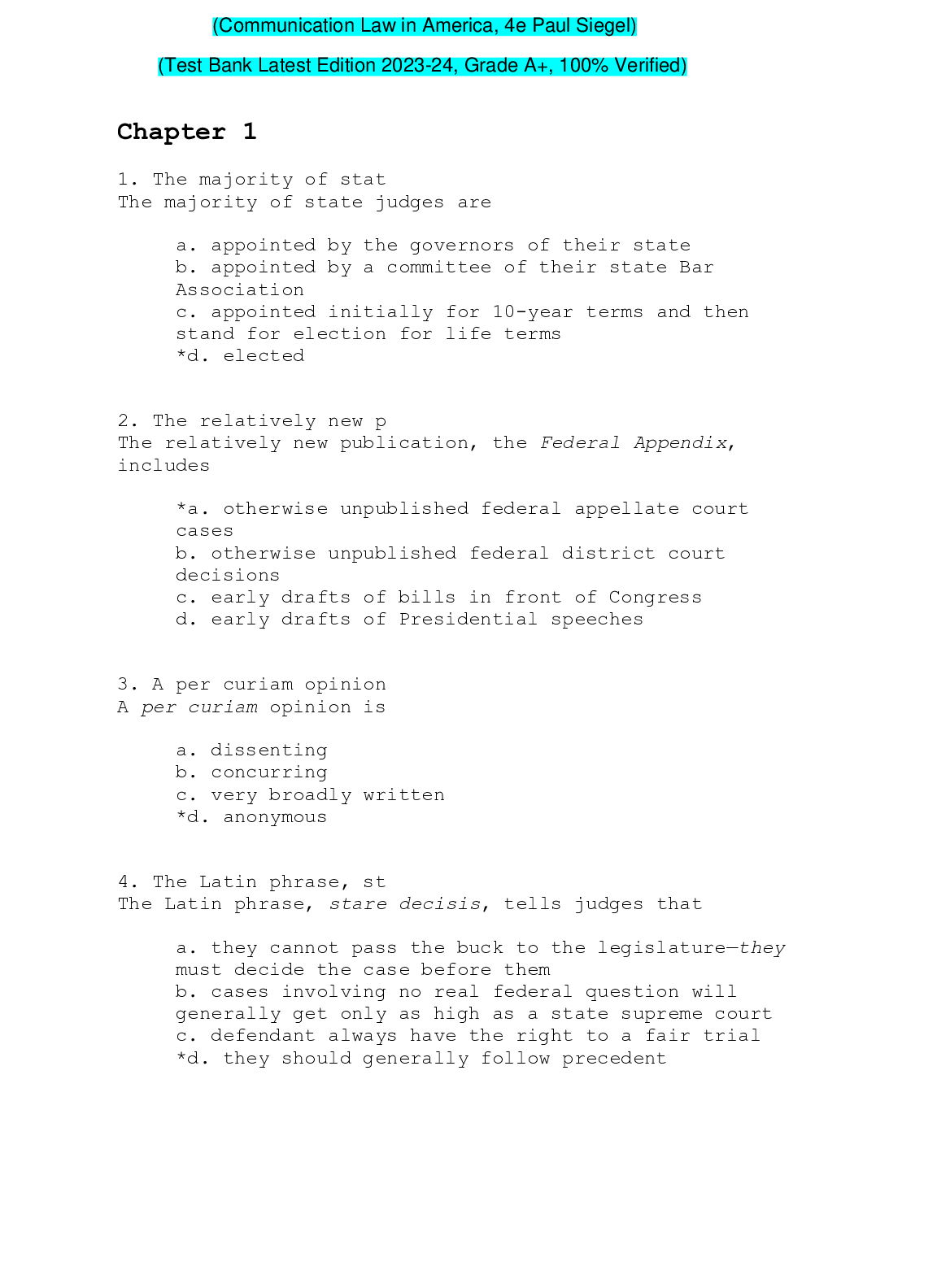Social Sciences > TEST BANK > College Physics A Strategic Approach, 4th edition By Randall D Knight, Brian Jones, Stuart Field (Te (All)
College Physics A Strategic Approach, 4th edition By Randall D Knight, Brian Jones, Stuart Field (Test Bank)
Document Content and Description Below
Full Version, All Chapters: Chs 1-30 Volume 1: Chs 1-16 Volume 2: Chs 17-30 PART I FORCE AND MOTION OVERVIEW The Science of Physics Representing Motion 1.1 Motion: A First Look 1.2 Models and M... odeling 1.3 Position and Time: Putting Numbers on Nature 1.4 Velocity 1.5 A Sense of Scale: Significant Figures, Scientific Notation, and Units 1.6 Vectors and Motion: A First Look 1.7 Where Do We Go from Here? SUMMARY QUESTIONS AND PROBLEMS Motion in One Dimension 2.1 Describing Motion 2.2 Uniform Motion 2.3 Instantaneous Velocity 2.4 Acceleration 2.5 Motion with Constant Acceleration 2.6 Solving One-Dimensional Motion Problems 2.7 Free Fall SUMMARY QUESTIONS AND PROBLEMS Vectors and Motion in Two Dimensions 3.1 Using Vectors 3.2 Coordinate Systems and Vector Components 3.3 Motion on a Ramp 3.4 Motion in Two Dimensions 3.5 Projectile Motion 3.6 Projectile Motion: Solving Problems 3.7 Circular Motion 3.8 Relative Motion SUMMARY QUESTIONS AND PROBLEMS Forces and Newton’s Laws of Motion 4.1 Motion and Forces 4.2 A Short Catalog of Forces 4.3 Identifying Forces 4.4 What Do Forces Do? 4.5 Newton’s Second Law 4.6 Free-Body Diagrams 4.7 Newton’s Third Law SUMMARY QUESTIONS AND PROBLEMS Applying Newton’s Laws 5.1 Equilibrium 5.2 Dynamics and Newton’s Second Law 5.3 Mass and Weight 5.4 Normal Forces 5.5 Friction 5.6 Drag 5.7 Interacting Objects 5.8 Ropes and Pulleys SUMMARY QUESTIONS AND PROBLEMS Circular Motion, Orbits, and Gravity 6.1 Uniform Circular Motion 6.2 Dynamics of Uniform Circular Motion 6.3 Apparent Forces in Circular Motion 6.4 Circular Orbits and Weightlessness 6.5 Newton’s Law of Gravity 6.6 Gravity and Orbits SUMMARY QUESTIONS AND PROBLEMS Rotational Motion 7.1 Describing Circular and Rotational Motion 7.2 The Rotation of a Rigid Body 7.3 Torque 7.4 Gravitational Torque and the Center of Gravity 7.5 Rotational Dynamics and Moment of Inertia 7.6 Using Newton’s Second Law for Rotation 7.7 Rolling Motion SUMMARY QUESTIONS AND PROBLEMS Equilibrium and Elasticity 8.1 Torque and Static Equilibrium 8.2 Stability and Balance 8.3 Springs and Hooke’s Law 8.4 Stretching and Compressing Materials 8.5 Forces and Torques in the Body SUMMARY QUESTIONS AND PROBLEMS PART I SUMMARY Force and Motion ONE STEP BEYOND Dark Matter and the Structure of the Universe PART I PROBLEMS PART II CONSERVATION LAWS OVERVIEW Why Some Things Stay the Same Momentum 9.1 Impulse 9.2 Momentum and the Impulse-Momentum Theorem 9.3 Solving Impulse and Momentum Problems 9.4 Conservation of Momentum 9.5 Inelastic Collisions 9.6 Momentum and Collisions in Two Dimensions 9.7 Angular Momentum SUMMARY QUESTIONS AND PROBLEMS Energy and Work 10.1 The Basic Energy Model 10.2 Work 10.3 Kinetic Energy 10.4 Potential Energy 10.5 Thermal Energy 10.6 Conservation of Energy 10.7 Energy Diagrams 10.8 Molecular Bonds and Chemical Energy 10.9 Energy in Collisions 10.10 Power SUMMARY QUESTIONS AND PROBLEMS Using Energy 11.1 Transforming Energy 11.2 Energy in the Body 11.3 Temperature, Thermal Energy, and Heat 11.4 The First Law of Thermodynamics 11.5 Heat Engines 11.6 Heat Pumps 11.7 Entropy and the Second Law of Thermodynamics 11.8 Systems, Energy, and Entropy SUMMARY QUESTIONS AND PROBLEMS PART II SUMMARY Conservation Laws ONE STEP BEYOND Order Out of Chaos PART II PROBLEMS PART III PROPERTIES OF MATTER OVERVIEW Beyond the Particle Model Thermal Properties of Matter 12.1 The Atomic Model of Matter 12.2 The Atomic Model of an Ideal Gas 12.3 Ideal-Gas Processes 12.4 Thermal Expansion 12.5 Specific Heat and Heat of Transformation 12.6 Calorimetry 12.7 Specific Heats of Gases 12.8 Heat Transfer 12.9 Diffusion SUMMARY QUESTIONS AND PROBLEMS Fluids 13.1 Fluids and Density 13.2 Pressure 13.3 Buoyancy 13.4 Fluids in Motion 13.5 Fluid Dynamics 13.6 Viscosity and Poiseuille’s Equation 13.7 The Circulatory System SUMMARY QUESTIONS AND PROBLEMS PART III SUMMARY Properties of Matter ONE STEP BEYOND Size and Life PART III PROBLEMS PART IV OSCILLATIONS AND WAVES OVERVIEW Motion That Repeats Again and Again Oscillations 14.1 Equilibrium and Oscillation 14.2 Linear Restoring Forces and SHM 14.3 Describing Simple Harmonic Motion 14.4 Energy in Simple Harmonic Motion 14.5 Pendulum Motion 14.6 Damped Oscillations 14.7 Driven Oscillations and Resonance SUMMARY QUESTIONS AND PROBLEMS Traveling Waves and Sound 15.1 The Wave Model 15.2 Traveling Waves 15.3 Graphical and Mathematical Descriptions of Waves 15.4 Sound and Light Waves 15.5 Energy and Intensity 15.6 Loudness of Sound 15.7 The Doppler Effect and Shock Waves SUMMARY QUESTIONS AND PROBLEMS Superposition and Standing Waves 16.1 The Principle of Superposition 16.2 Standing Waves 16.3 Standing Waves on a String 16.4 Standing Sound Waves 16.5 Speech and Hearing 16.6 The Interference of Waves from Two Sources 16.7 Beats SUMMARY QUESTIONS AND PROBLEMS PART IV SUMMARY Oscillations and Waves ONE STEP BEYOND Waves in the Earth and the Ocean PART IV PROBLEMS PART V OPTICS OVERVIEW Light Is a Wave Wave Optics 17.1 What Is Light? 17.2 The Interference of Light 17.3 The Diffraction Grating 17.4 Thin-Film Interference 17.5 Single-Slit Diffraction 17.6 Circular-Aperture Diffraction SUMMARY QUESTIONS AND PROBLEMS Ray Optics 18.1 The Ray Model of Light 18.2 Reflection 18.3 Refraction 18.4 Image Formation by Refraction 18.5 Thin Lenses: Ray Tracing 18.6 Image Formation with Spherical Mirrors 18.7 The Thin-Lens Equation SUMMARY QUESTIONS AND PROBLEMS Optical Instruments 19.1 The Camera 19.2 The Human Eye 19.3 The Magnifier 19.4 The Microscope 19.5 The Telescope 19.6 Color and Dispersion 19.7 Resolution of Optical Instruments SUMMARY QUESTIONS AND PROBLEMS PART V SUMMARY Optics ONE STEP BEYOND Scanning Confocal Microscopy PART V PROBLEMS PART VI ELECTRICITY AND MAGNETISM OVERVIEW Charges, Currents, and Fields Electric Fields and Forces 20.1 Charges and Forces 20.2 Charges, Atoms, and Molecules 20.3 Coulomb’s Law 20.4 The Concept of the Electric Field 20.5 The Electric Field from Arrangements of Charges 20.6 Conductors and Electric Fields 20.7 Forces and Torques in Electric Fields SUMMARY QUESTIONS AND PROBLEMS Electric Potential 21.1 Electric Potential Energy and Electric Potential 21.2 Sources of Electric Potential 21.3 Electric Potential and Conservation of Energy 21.4 Calculating the Electric Potential 21.5 Connecting Potential and Field 21.6 The Electrocardiogram 21.7 Capacitance and Capacitors 21.8 Energy and Capacitors SUMMARY QUESTIONS AND PROBLEMS Current and Resistance 22.1 A Model of Current 22.2 Defining and Describing Current 22.3 Batteries and emf 22.4 Connecting Potential and Current 22.5 Ohm’s Law and Resistor Circuits 22.6 Energy and Power SUMMARY QUESTIONS AND PROBLEMS Circuits 23.1 Circuit Elements and Diagrams 23.2 Kirchhoff’s Laws 23.3 Series and Parallel Circuits 23.4 Measuring Voltage and Current 23.5 More Complex Circuits 23.6 Capacitors in Parallel and Series 23.7 RC Circuits 23.8 Electricity in the Nervous System SUMMARY QUESTIONS AND PROBLEMS Magnetic Fields and Forces 24.1 Magnetism 24.2 The Magnetic Field 24.3 Electric Currents Also Create Magnetic Fields 24.4 Calculating the Magnetic Field Due to a Current 24.5 Magnetic Fields Exert Forces on Moving Charges 24.6 Magnetic Fields Exert Forces on Currents 24.7 Magnetic Fields Exert Torques on Dipoles 24.8 Magnets and Magnetic Materials SUMMARY QUESTIONS AND PROBLEMS EM Induction and EM Waves 25.1 Induced Currents 25.2 Motional emf 25.3 Magnetic Flux and Lenz’s Law 25.4 Faraday’s Law 25.5 Electromagnetic Waves 25.6 The Photon Model of Electromagnetic Waves 25.7 The Electromagnetic Spectrum SUMMARY QUESTIONS AND PROBLEMS AC Electricity 26.1 Alternating Current 26.2 AC Electricity and Transformers 26.3 Household Electricity 26.4 Biological Effects and Electrical Safety 26.5 Capacitor Circuits 26.6 Inductors and Inductor Circuits 26.7 Oscillation Circuits SUMMARY QUESTIONS AND PROBLEMS PART VI SUMMARY Electricity and Magnetism ONE STEP BEYOND The Greenhouse Effect and Global Warming PART VI PROBLEMS PART VII MODERN PHYSICS OVERVIEW New Ways of Looking at the World Relativity 27.1 Relativity: What’s It All About? 27.2 Galilean Relativity 27.3 Einstein’s Principle of Relativity 27.4 Events and Measurements 27.5 The Relativity of Simultaneity 27.6 Time Dilation 27.7 Length Contraction 27.8 Velocities of Objects in Special Relativity 27.9 Relativistic Momentum 27.10 Relativistic Energy SUMMARY QUESTIONS AND PROBLEMS Quantum Physics 28.1 X Rays and X-Ray Diffraction 28.2 The Photoelectric Effect 28.3 Photons 28.4 Matter Waves 28.5 Energy Is Quantized 28.6 Energy Levels and Quantum Jumps 28.7 The Uncertainty Principle 28.8 Applications and Implications of Quantum Theory SUMMARY QUESTIONS AND PROBLEMS Atoms and Molecules 29.1 Spectroscopy 29.2 Atoms 29.3 Bohr’s Model of Atomic Quantization 29.4 The Bohr Hydrogen Atom 29.5 The Quantum-Mechanical Hydrogen Atom 29.6 Multi-electron Atoms 29.7 Excited States and Spectra 29.8 Molecules 29.9 Stimulated Emission and Lasers SUMMARY QUESTIONS AND PROBLEMS Nuclear Physics 30.1 Nuclear Structure 30.2 Nuclear Stability 30.3 Forces and Energy in the Nucleus 30.4 Radiation and Radioactivity 30.5 Nuclear Decay and Half-Lives 30.6 Medical Applications of Nuclear Physics 30.7 The Ultimate Building Blocks of Matter SUMMARY QUESTIONS AND PROBLEMS PART VII SUMMARY MODERN PHYSICS ONE STEP BEYOND The Physics of Very Cold Atoms PART VII PROBLEMS APPENDICES Mathematics Review Periodic Table of Elements Atomic and Nuclear Data Answers to Odd-Numbered Problems Full Version, All Chapters: Chs 1-30 Volume 1: Chs 1-16 Volume 2: Chs 17-30 PART I FORCE AND MOTION OVERVIEW The Science of Physics Representing Motion 1.1 Motion: A First Look 1.2 Models and Modeling 1.3 Position and Time: Putting Numbers on Nature 1.4 Velocity 1.5 A Sense of Scale: Significant Figures, Scientific Notation, and Units 1.6 Vectors and Motion: A First Look 1.7 Where Do We Go from Here? SUMMARY QUESTIONS AND PROBLEMS Motion in One Dimension 2.1 Describing Motion 2.2 Uniform Motion 2.3 Instantaneous Velocity 2.4 Acceleration 2.5 Motion with Constant Acceleration 2.6 Solving One-Dimensional Motion Problems 2.7 Free Fall SUMMARY QUESTIONS AND PROBLEMS Vectors and Motion in Two Dimensions 3.1 Using Vectors 3.2 Coordinate Systems and Vector Components 3.3 Motion on a Ramp 3.4 Motion in Two Dimensions 3.5 Projectile Motion 3.6 Projectile Motion: Solving Problems 3.7 Circular Motion 3.8 Relative Motion SUMMARY QUESTIONS AND PROBLEMS Forces and Newton’s Laws of Motion 4.1 Motion and Forces 4.2 A Short Catalog of Forces 4.3 Identifying Forces 4.4 What Do Forces Do? 4.5 Newton’s Second Law 4.6 Free-Body Diagrams 4.7 Newton’s Third Law SUMMARY QUESTIONS AND PROBLEMS Applying Newton’s Laws 5.1 Equilibrium 5.2 Dynamics and Newton’s Second Law 5.3 Mass and Weight 5.4 Normal Forces 5.5 Friction 5.6 Drag 5.7 Interacting Objects 5.8 Ropes and Pulleys SUMMARY QUESTIONS AND PROBLEMS Circular Motion, Orbits, and Gravity 6.1 Uniform Circular Motion 6.2 Dynamics of Uniform Circular Motion 6.3 Apparent Forces in Circular Motion 6.4 Circular Orbits and Weightlessness 6.5 Newton’s Law of Gravity 6.6 Gravity and Orbits SUMMARY QUESTIONS AND PROBLEMS Rotational Motion 7.1 Describing Circular and Rotational Motion 7.2 The Rotation of a Rigid Body 7.3 Torque 7.4 Gravitational Torque and the Center of Gravity 7.5 Rotational Dynamics and Moment of Inertia 7.6 Using Newton’s Second Law for Rotation 7.7 Rolling Motion SUMMARY QUESTIONS AND PROBLEMS Equilibrium and Elasticity 8.1 Torque and Static Equilibrium 8.2 Stability and Balance 8.3 Springs and Hooke’s Law 8.4 Stretching and Compressing Materials 8.5 Forces and Torques in the Body SUMMARY QUESTIONS AND PROBLEMS PART I SUMMARY Force and Motion ONE STEP BEYOND Dark Matter and the Structure of the Universe PART I PROBLEMS PART II CONSERVATION LAWS OVERVIEW Why Some Things Stay the Same Momentum 9.1 Impulse 9.2 Momentum and the Impulse-Momentum Theorem 9.3 Solving Impulse and Momentum Problems 9.4 Conservation of Momentum 9.5 Inelastic Collisions 9.6 Momentum and Collisions in Two Dimensions 9.7 Angular Momentum SUMMARY QUESTIONS AND PROBLEMS Energy and Work 10.1 The Basic Energy Model 10.2 Work 10.3 Kinetic Energy 10.4 Potential Energy 10.5 Thermal Energy 10.6 Conservation of Energy 10.7 Energy Diagrams 10.8 Molecular Bonds and Chemical Energy 10.9 Energy in Collisions 10.10 Power SUMMARY QUESTIONS AND PROBLEMS Using Energy 11.1 Transforming Energy 11.2 Energy in the Body 11.3 Temperature, Thermal Energy, and Heat 11.4 The First Law of Thermodynamics 11.5 Heat Engines 11.6 Heat Pumps 11.7 Entropy and the Second Law of Thermodynamics 11.8 Systems, Energy, and Entropy SUMMARY QUESTIONS AND PROBLEMS PART II SUMMARY Conservation Laws ONE STEP BEYOND Order Out of Chaos PART II PROBLEMS PART III PROPERTIES OF MATTER OVERVIEW Beyond the Particle Model Thermal Properties of Matter 12.1 The Atomic Model of Matter 12.2 The Atomic Model of an Ideal Gas 12.3 Ideal-Gas Processes 12.4 Thermal Expansion 12.5 Specific Heat and Heat of Transformation 12.6 Calorimetry 12.7 Specific Heats of Gases 12.8 Heat Transfer 12.9 Diffusion SUMMARY QUESTIONS AND PROBLEMS Fluids 13.1 Fluids and Density 13.2 Pressure 13.3 Buoyancy 13.4 Fluids in Motion 13.5 Fluid Dynamics 13.6 Viscosity and Poiseuille’s Equation 13.7 The Circulatory System SUMMARY QUESTIONS AND PROBLEMS PART III SUMMARY Properties of Matter ONE STEP BEYOND Size and Life PART III PROBLEMS PART IV OSCILLATIONS AND WAVES OVERVIEW Motion That Repeats Again and Again Oscillations 14.1 Equilibrium and Oscillation 14.2 Linear Restoring Forces and SHM 14.3 Describing Simple Harmonic Motion 14.4 Energy in Simple Harmonic Motion 14.5 Pendulum Motion 14.6 Damped Oscillations 14.7 Driven Oscillations and Resonance SUMMARY QUESTIONS AND PROBLEMS Traveling Waves and Sound 15.1 The Wave Model 15.2 Traveling Waves 15.3 Graphical and Mathematical Descriptions of Waves 15.4 Sound and Light Waves 15.5 Energy and Intensity 15.6 Loudness of Sound 15.7 The Doppler Effect and Shock Waves SUMMARY QUESTIONS AND PROBLEMS Superposition and Standing Waves 16.1 The Principle of Superposition 16.2 Standing Waves 16.3 Standing Waves on a String 16.4 Standing Sound Waves 16.5 Speech and Hearing 16.6 The Interference of Waves from Two Sources 16.7 Beats SUMMARY QUESTIONS AND PROBLEMS PART IV SUMMARY Oscillations and Waves ONE STEP BEYOND Waves in the Earth and the Ocean PART IV PROBLEMS PART V OPTICS OVERVIEW Light Is a Wave Wave Optics 17.1 What Is Light? 17.2 The Interference of Light 17.3 The Diffraction Grating 17.4 Thin-Film Interference 17.5 Single-Slit Diffraction 17.6 Circular-Aperture Diffraction SUMMARY QUESTIONS AND PROBLEMS Ray Optics 18.1 The Ray Model of Light 18.2 Reflection 18.3 Refraction 18.4 Image Formation by Refraction 18.5 Thin Lenses: Ray Tracing 18.6 Image Formation with Spherical Mirrors 18.7 The Thin-Lens Equation SUMMARY QUESTIONS AND PROBLEMS Optical Instruments 19.1 The Camera 19.2 The Human Eye 19.3 The Magnifier 19.4 The Microscope 19.5 The Telescope 19.6 Color and Dispersion 19.7 Resolution of Optical Instruments SUMMARY QUESTIONS AND PROBLEMS PART V SUMMARY Optics ONE STEP BEYOND Scanning Confocal Microscopy PART V PROBLEMS PART VI ELECTRICITY AND MAGNETISM OVERVIEW Charges, Currents, and Fields Electric Fields and Forces 20.1 Charges and Forces 20.2 Charges, Atoms, and Molecules 20.3 Coulomb’s Law 20.4 The Concept of the Electric Field 20.5 The Electric Field from Arrangements of Charges 20.6 Conductors and Electric Fields 20.7 Forces and Torques in Electric Fields SUMMARY QUESTIONS AND PROBLEMS Electric Potential 21.1 Electric Potential Energy and Electric Potential 21.2 Sources of Electric Potential 21.3 Electric Potential and Conservation of Energy 21.4 Calculating the Electric Potential 21.5 Connecting Potential and Field 21.6 The Electrocardiogram 21.7 Capacitance and Capacitors 21.8 Energy and Capacitors SUMMARY QUESTIONS AND PROBLEMS Current and Resistance 22.1 A Model of Current 22.2 Defining and Describing Current 22.3 Batteries and emf 22.4 Connecting Potential and Current 22.5 Ohm’s Law and Resistor Circuits 22.6 Energy and Power SUMMARY QUESTIONS AND PROBLEMS Circuits 23.1 Circuit Elements and Diagrams 23.2 Kirchhoff’s Laws 23.3 Series and Parallel Circuits 23.4 Measuring Voltage and Current 23.5 More Complex Circuits 23.6 Capacitors in Parallel and Series 23.7 RC Circuits 23.8 Electricity in the Nervous System SUMMARY QUESTIONS AND PROBLEMS Magnetic Fields and Forces 24.1 Magnetism 24.2 The Magnetic Field 24.3 Electric Currents Also Create Magnetic Fields 24.4 Calculating the Magnetic Field Due to a Current 24.5 Magnetic Fields Exert Forces on Moving Charges 24.6 Magnetic Fields Exert Forces on Currents 24.7 Magnetic Fields Exert Torques on Dipoles 24.8 Magnets and Magnetic Materials SUMMARY QUESTIONS AND PROBLEMS EM Induction and EM Waves 25.1 Induced Currents 25.2 Motional emf 25.3 Magnetic Flux and Lenz’s Law 25.4 Faraday’s Law 25.5 Electromagnetic Waves 25.6 The Photon Model of Electromagnetic Waves 25.7 The Electromagnetic Spectrum SUMMARY QUESTIONS AND PROBLEMS AC Electricity 26.1 Alternating Current 26.2 AC Electricity and Transformers 26.3 Household Electricity 26.4 Biological Effects and Electrical Safety 26.5 Capacitor Circuits 26.6 Inductors and Inductor Circuits 26.7 Oscillation Circuits SUMMARY QUESTIONS AND PROBLEMS PART VI SUMMARY Electricity and Magnetism ONE STEP BEYOND The Greenhouse Effect and Global Warming PART VI PROBLEMS PART VII MODERN PHYSICS OVERVIEW New Ways of Looking at the World Relativity 27.1 Relativity: What’s It All About? 27.2 Galilean Relativity 27.3 Einstein’s Principle of Relativity 27.4 Events and Measurements 27.5 The Relativity of Simultaneity 27.6 Time Dilation 27.7 Length Contraction 27.8 Velocities of Objects in Special Relativity 27.9 Relativistic Momentum 27.10 Relativistic Energy SUMMARY QUESTIONS AND PROBLEMS Quantum Physics 28.1 X Rays and X-Ray Diffraction 28.2 The Photoelectric Effect 28.3 Photons 28.4 Matter Waves 28.5 Energy Is Quantized 28.6 Energy Levels and Quantum Jumps 28.7 The Uncertainty Principle 28.8 Applications and Implications of Quantum Theory SUMMARY QUESTIONS AND PROBLEMS Atoms and Molecules 29.1 Spectroscopy 29.2 Atoms 29.3 Bohr’s Model of Atomic Quantization 29.4 The Bohr Hydrogen Atom 29.5 The Quantum-Mechanical Hydrogen Atom 29.6 Multi-electron Atoms 29.7 Excited States and Spectra 29.8 Molecules 29.9 Stimulated Emission and Lasers SUMMARY QUESTIONS AND PROBLEMS Nuclear Physics 30.1 Nuclear Structure 30.2 Nuclear Stability 30.3 Forces and Energy in the Nucleus 30.4 Radiation and Radioactivity 30.5 Nuclear Decay and Half-Lives 30.6 Medical Applications of Nuclear Physics 30.7 The Ultimate Building Blocks of Matter SUMMARY QUESTIONS AND PROBLEMS PART VII SUMMARY MODERN PHYSICS ONE STEP BEYOND The Physics of Very Cold Atoms PART VII PROBLEMS APPENDICES Mathematics Review Periodic Table of Elements Atomic and Nuclear Data Answers to Odd-Numbered Problems [Show More]
Last updated: 1 year ago
Preview 1 out of 119 pages
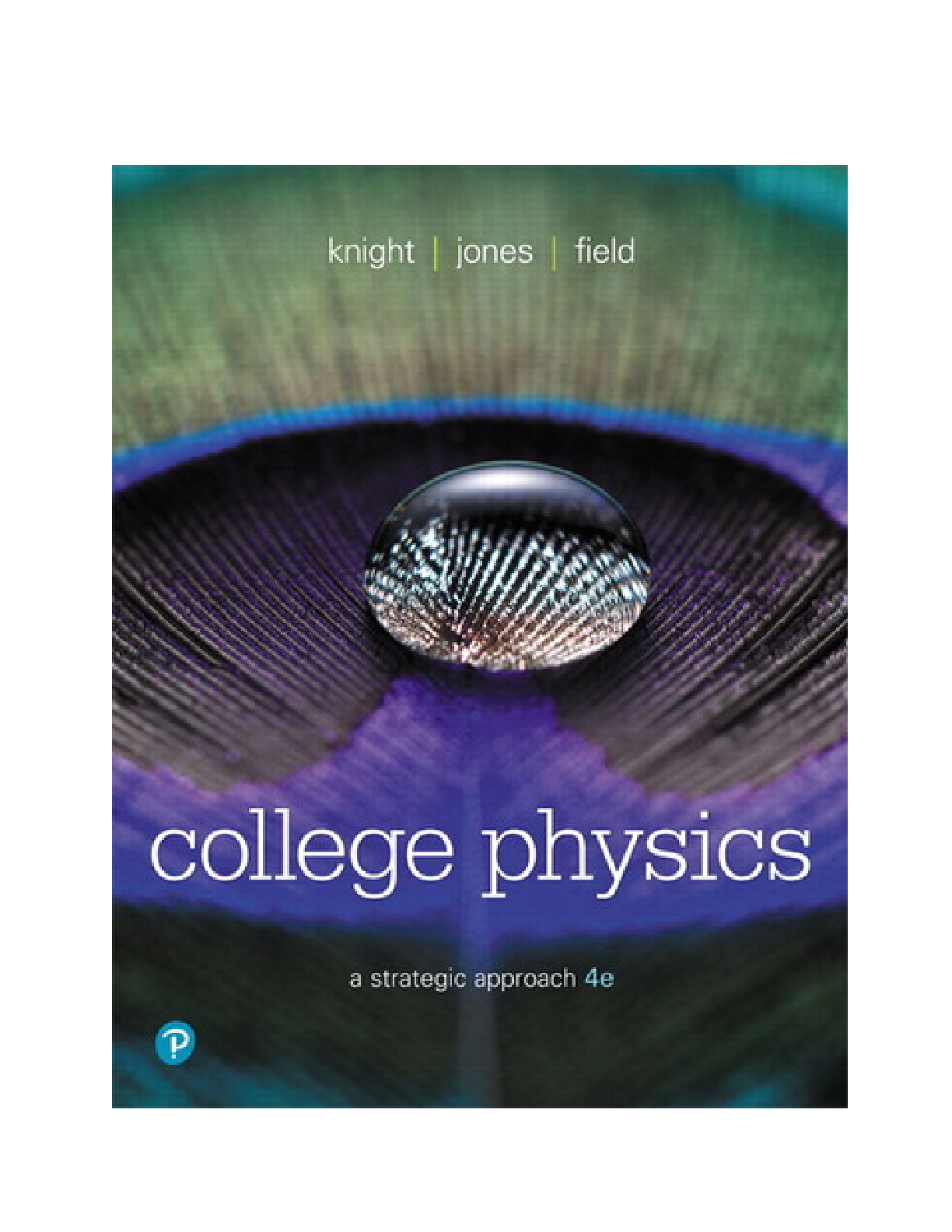
Reviews( 0 )
Document information
Connected school, study & course
About the document
Uploaded On
Nov 20, 2022
Number of pages
119
Written in
Additional information
This document has been written for:
Uploaded
Nov 20, 2022
Downloads
0
Views
37

